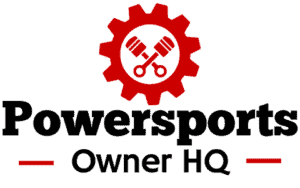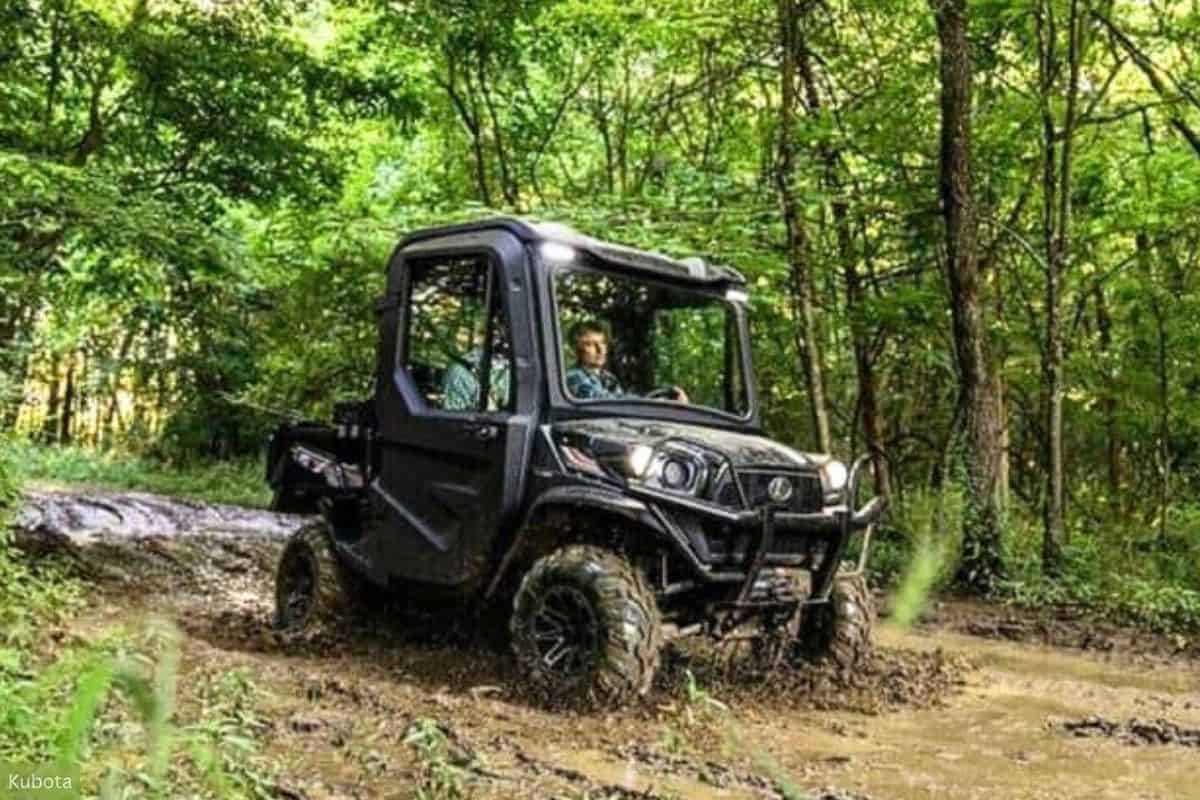When it comes to off-road adventures and tackling tough jobs, UTVs have become the go-to choice for many enthusiasts and professionals.
These rugged, versatile machines, also known as side-by-sides, offer a perfect combination of performance, utility, and off-road capability.
However, with so many UTV brands and models on the market, it’s easy to become overwhelmed, when trying to choose the best side-by-side for your needs.
One of the best places to start though when comparing UTVs is horsepower, as it directly impacts acceleration, top speed, towing capacity, and overall performance.
Whether you’re looking to tackle tough trails, haul heavy loads, or simply enjoy a fun ride with friends and family, UTV horsepower is the one element that affects all these activities.
But how much horsepower does the average UTV have and how much do you actually need?
We’ll answer both these questions and more in this blog post all about UTV horsepower.
Key Takeaways:
- UTV horsepower can range from as little as 16 to as much as 181 HP, however, most models range from 40 to 100 HP.
- The average UTV or side-by-side horsepower is 73.
- UTV horsepower directly impacts acceleration, top speed, towing capacity, and overall performance.
- Factors like engine size, air intakes, fuel injection, turbocharging, and exhaust systems can all affect side-by-side horsepower.
Popular UTV Models (Lowest to Highest Horsepower)
| Make/Model/Trim | Horsepower | Displacement | Class |
|---|---|---|---|
| 1. Hisun Sector 250 | 16 HP | 229cc | Utility |
| 2. Massimo Motor Buck 450 | 25 HP | 352cc | Utility |
| 3. Honda Pioneer 520 | 30 HP | 518cc | Utility |
| 4. Kymco USA UXV 450I | 33 HP | 443cc | Utility |
| 5. CFMoto UForce 600 | 40 HP | 580cc | Utility |
| 6. Polaris Ranger SP 570 | 44 HP | 567cc | Utility |
| 7. Kawasaki Mule PRO-FXT | 47 HP | 812cc | Utility |
| 8. Arctic Cat Prowler Pro EPS | 50 HP | 812cc | Utility |
| 9. Can-Am Maverick Trail 700 | 52 HP | 650cc | Utility |
| 10. Kubota Sidekick RTV-XG850 | 54 HP | 851cc | Utility |
| 11. John Deere XUV835E | 54 HP | 812cc | Utility |
| 12. CFMOTO ZFORCE 800 Trail | 62 HP | 800cc | Sport |
| 13. Honda Pioneer 1000 | 72 HP | 999cc | Utility |
| 14. Can-Am Defender 6X6 DPS HD10 | 82 HP | 976cc | Utility |
| 15. Polaris Ranger Crew XP 1000 | 82 HP | 999cc | Utility |
| 16. Can-Am Commander XT 1000 | 100 HP | 976cc | Sport |
| 17. Yamaha YXZ 1000R | 101 HP | 998cc | Sport |
| 18. Segway Fugleman UT10 | 105 HP | 1000cc | Utility |
| 19. Honda Talon 1000X-4 | 105 HP | 999cc | Sport |
| 20. Segway Villain SX10 WX | 105 HP | 1000cc | Sport |
| 21. Kawasaki Teryx KRX 1000 | 116 HP | 999cc | Sport |
| 22. Arctic Cat Wildcat XX BH Edition | 130 HP | 998cc | Sport |
| 23. Polaris RZR Turbo R 4 Ultimate | 181 HP | 925cc | Sport |
Average UTV Horsepower
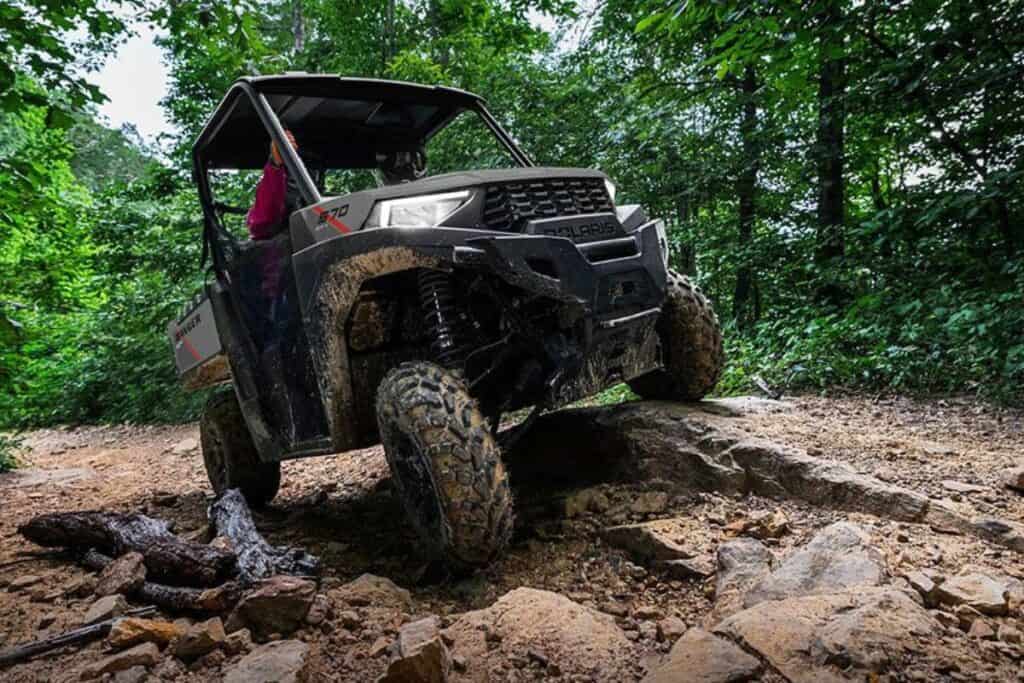
When comparing the horsepower of UTV models, it’s important to understand the average horsepower range to gauge the performance of a particular machine.
As you can see from the above table, UTV horsepower can range from as little as 16 to as much as 181 HP.
However, most UTV models have horsepower ratings from 40 to 100, with the average UTV having around 73 horsepower.
Breaking Down UTV Horsepower
Understanding the average UTV horsepower range helps enthusiasts and professionals make informed decisions when selecting a model that best suits their needs, whether for utility tasks or high-octane adventures.
Utility UTV Models
On the lower end of the horsepower spectrum, off-brand utility UTVs like the Hisun Sector 250 and Massimo Motor Buck 450 offer between 15 and 25 horsepower.
These models are suitable for light-duty tasks and leisurely trail rides.
Mid-range utility UTVs, such as the Honda Pioneer 520, Kymco USA UXV 450I, and CFMoto UForce 600, provide between 30 and 40 horsepower, which is sufficient for most recreational and work-related tasks.
Higher-end utility UTVs, like the Polaris Ranger SP 570, Kawasaki Mule PRO-FXT, and Arctic Cat Prowler Pro EPS, offer horsepower ratings between 40 and 50 HP, which provide improved performance and towing capabilities.
Some of the most powerful utility UTVs, such as the Can-Am Defender 6X6 DPS HD10 and Polaris Ranger Crew XP 1000, deliver an impressive 82 HP, making them great for demanding tasks and challenging terrains.
Sport UTV Models
Sport UTVs generally offer higher horsepower ratings compared to their utility counterparts.
Models like the CFMOTO ZFORCE 800 Trail and Can-Am Commander XT 1000 provide between 60 and 100 horsepower, ensuring a thrilling and exciting ride.
High-performance sport UTVs, such as the Yamaha YXZ 1000R, Honda Talon 1000X-4, and Segway Villain SX10 WX, offer horsepower ratings ranging from 100 to 110 HP, delivering unmatched speed and agility on the trails.
At the top of the horsepower spectrum, the Kawasaki Teryx KRX 1000, Arctic Cat Wildcat XX Black Hills Edition, and Polaris RZR Turbo R Ultimate generate between 115 and an astonishing 181 HP, catering to the most demanding high-performance and racing applications.
Understanding Side-By-Side Horsepower
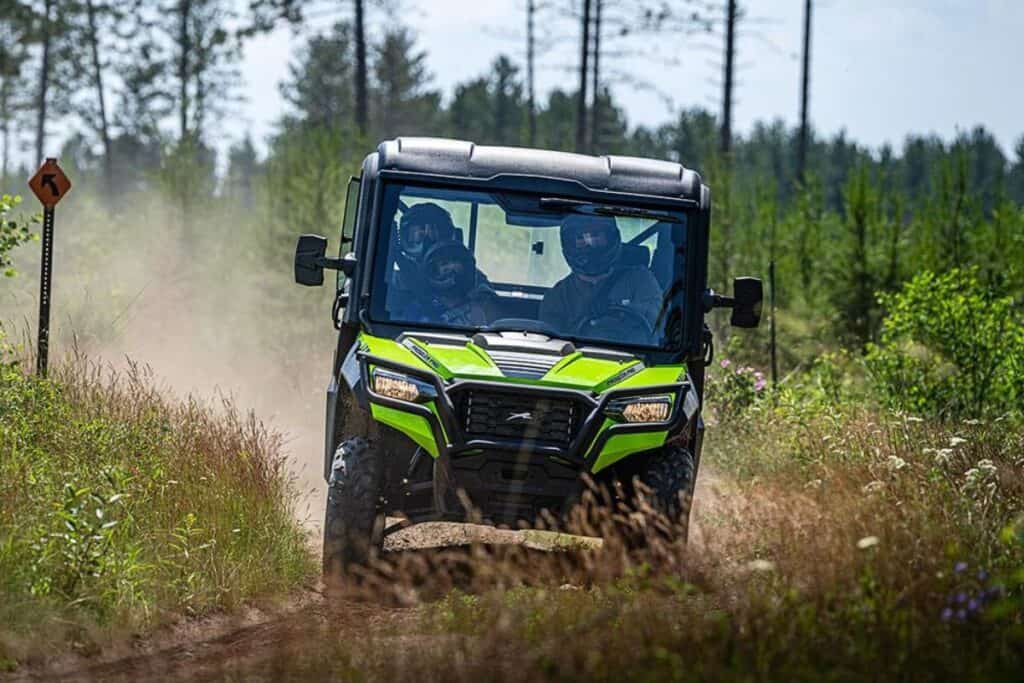
When shopping for a side-by-side or UTV, one of the most important factors to consider is horsepower.
As it directly impacts a UTV’s performance, including its acceleration, top speed, towing capacity, and overall capability.
To fully understand how horsepower affects all these factors though, we need to take a closer look at side-by-side horsepower.
Factors that Affect UTV Horsepower
Several key factors play a role in determining a UTV’s horsepower output.
Understanding these factors can help you make a more informed decision when comparing different models and selecting the one that best fits your needs.
- Engine Size and Type: The engine size or displacement, measured in cubic centimeters (cc), is one of the most significant factors affecting UTV horsepower. Generally, larger engines produce more horsepower than smaller ones. Additionally, the type of engine, such as single-cylinder or twin-cylinder can impact horsepower output and overall performance.
- Fuel Injection Systems: Modern UTVs often use fuel injection systems over carburation, which can optimize fuel delivery and improve engine efficiency. Electronic Fuel Injection (EFI) systems, for example, can help increase horsepower and torque while providing better throttle response and fuel economy compared to carbureted engines.
- Turbocharging and Supercharging: Some high-performance UTV models come equipped with turbochargers or superchargers, which force more air into the engine, allowing for more fuel to be burned and resulting in increased horsepower. Turbocharging and supercharging can significantly boost horsepower output, but they also add complexity and cost to the vehicle.
- Exhaust Systems and Upgrades: The design of a UTV’s exhaust system can impact its horsepower output. High-flow exhaust systems and aftermarket exhaust upgrades can help reduce backpressure and improve engine breathing, resulting in increased horsepower.
Horsepower Vs Torque on Side-By-Sides
When discussing side-by-side performance, horsepower tends to receive most of the attention, however, torque is equally important in determining a UTV’s capabilities.
Because of this, understanding the difference between horsepower and torque, as well as their roles in UTV performance, can help you make a more informed decision when selecting a model for your specific needs.
In general, higher horsepower means better top speed and faster acceleration, which can be beneficial for racing, high-speed trail riding, and certain work applications.
Torque, on the other hand, is a measure of rotational force. In the context of UTVs, torque represents the twisting force that the engine produces to turn the wheels.
High torque output is especially important for low-speed, high-demand applications such as towing, hauling, and navigating rough terrain or steep inclines.
UTVs with high torque tend to have better low-end power and can more easily maintain momentum in challenging conditions.
The ideal balance between horsepower and torque depends on your specific use case.
For example, if you primarily use your UTV for high-speed trail riding, a model with higher horsepower and a wider power band may be better.
On the other hand, if you frequently engage in heavy-duty work tasks or navigate challenging terrain at lower speeds, a UTV with higher torque output may be more beneficial.
It’s important to note, however, that horsepower and torque are not mutually exclusive, as many modern UTVs offer a good balance of both.
In fact, powersport manufacturers often tune engines to deliver power and torque curves that suit a wide range of applications using advanced technologies like variable valve timing, turbocharging, and intelligent engine mapping to optimize performance across a wide range of operating conditions.
How Much Horsepower Do You Need?
When selecting a UTV, it’s important to consider how its horsepower and overall performance align with your intended use.
As different applications require different levels of horsepower, and understanding these requirements can help you choose the right model the first time.
Intended Use:
- Trail Riding and Recreational Use: For casual trail riding and recreational use, a UTV with moderate horsepower, between 30 and 60 HP, can provide a fun experience. These models offer a good balance of power and maneuverability, making them suitable for exploring trails, navigating moderate terrain, and enjoying leisurely rides with friends and family.
- Utility Tasks and Work-Related Use: For utility tasks and work applications, such as farming, landscaping, or construction, a UTV with ample low-end torque and moderate horsepower is often the best choice. Models with horsepower ratings between 40 and 80 HP typically offer a good balance of power and efficiency for hauling, towing, and navigating rough terrain. Look for UTVs with high payload and towing capacities.
- Hunting and Outdoor Recreation: When using a UTV for hunting or outdoor recreation, a model with moderate horsepower and good low-end torque is great for navigating off-road terrain, hauling gear, and accessing remote locations. UTVs with horsepower ratings between 50 and 80 HP are often best-suited for these applications, offering a balance of power, efficiency, and maneuverability.
- Dunes and Desert Running: For dune and desert running, a UTV with high horsepower and advanced suspension is essential to tackle challenging terrain and maintain high speeds. Models with horsepower ratings above 100 HP, long-travel suspension, and high-performance tires are well-suited for these demanding environments.
- Racing and High-Performance Riding: If you’re interested in UTV racing or high-performance riding, you’ll likely want a model with high horsepower, above 100 HP. These high-performance UTVs are designed for speed, acceleration, and agility, allowing you to tackle challenging tracks and compete at the highest levels. Models with advanced suspension systems, lightweight construction, and high-output engines are well-suited for racing applications.
UTV Models with the Highest Horsepower
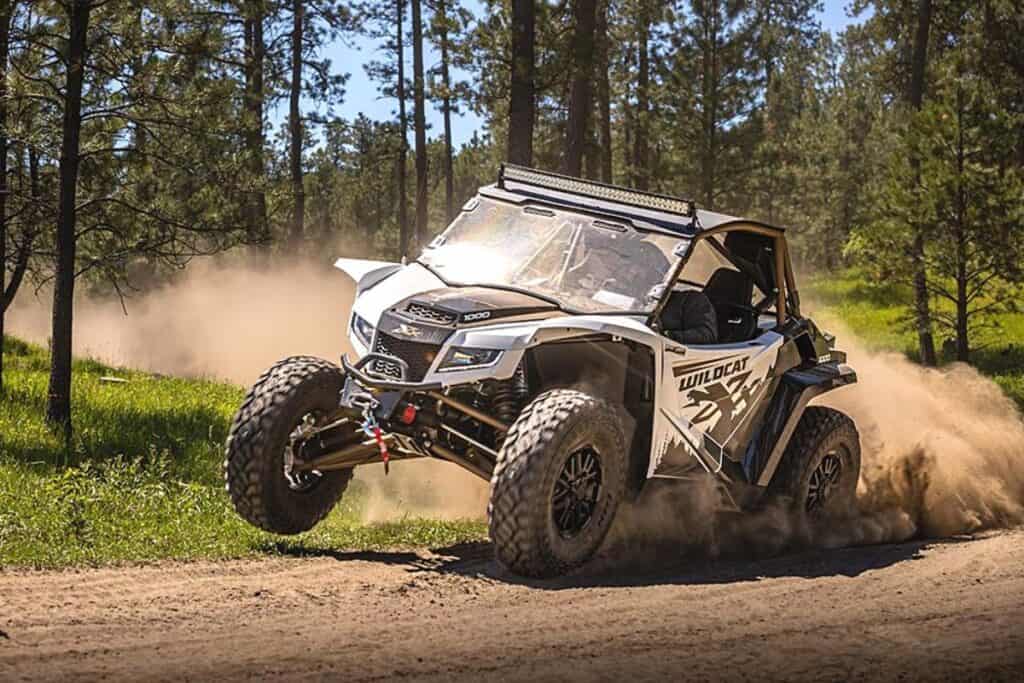
High-horsepower side-by-sides offer unmatched speed, acceleration, and thrills, making them the top choice for racing enthusiasts, dune riders, and adrenaline junkies.
These models offer powerful advanced engines, high-performance suspension systems, and cutting-edge technologies that allow them to push the boundaries of what’s possible in a UTV.
So let’s take a closer look at these UTVs to see what makes them so special.
Kawasaki Teryx KRX 1000
Quick Specs
- Average Cost: $16,000
- Displacement: 999cc
- Engine: Liquid-cooled, Parallel-twin, 4-stroke, DOHC, 8-valve
- Horsepower: 116 HP
- Torque: 76.7 Pound Feet
- Weight: 1,896.3 Pounds
- Ground Clearance: 14.8 Inches
The Teryx KRX 1000 is Kawasaki’s flagship sport UTV that offers maximum off-road and trail-riding capability.
This high-performance machine boasts a powerful 999cc parallel-twin engine that delivers an impressive 116 horsepower, making it one of the most powerful UTVs in its class.
The engine is paired with a smooth-shifting continuously variable transmission (CVT) and a selectable four-wheel-drive system, ensuring optimal power delivery and traction in various terrains.
The Teryx KRX 1000 features a robust, high-strength tubular steel frame and a long-travel suspension system with Fox 2.5 Podium LSC shocks, providing exceptional ground clearance, stability, and rider comfort.
The UTV’s aggressive styling, spacious cabin, and advanced technology features, such as a multi-function digital display with a bar-style tachometer, further enhance its appeal to adventure-seeking enthusiasts.
To learn more about the Kawasaki Teryx KRX 1000, check out Kawasaki’s website by clicking here.
Arctic Cat Wildcat XX Black Hills Edition
Quick Specs
- Average Cost: $28,000
- Displacement: 998cc
- Engine: Liquid-cooled Three-cylinder, EFI, 4-stroke
- Horsepower: 130 HP
- Weight: 1,918 Pounds
- Ground Clearance: 15 Inches
Offering 130 horsepower, the Arctic Cat Wildcat XX Black Hills Edition has one of the highest horsepower ratings available on a UTV.
This special edition model is powered by a 998cc DOHC inline-three-cylinder engine that delivers massive horsepower and torque, making it a top choice for high-performance off-road enthusiasts.
The engine is mated to a rapid-response clutch system and ADAPT CVT transmission, ensuring smooth power delivery and optimal performance.
The Wildcat XX Black Hills Edition also features a race-inspired, high-strength chassis and a premium suspension system with FOX 2.5 PODIUM QS3 shocks, providing next-level handling.
Which allows you to stay in control of all that power.
The UTV also offers an aggressive design, a front bumper with a Warn 3,500-pound winch, rock sliders, and a standard roof.
As well as the latest tech, including a multifunction digital gauge and a dash-mounted Garmin Tread Off Road GPS that you can operate with your gloves.
For more information on the Arctic Cat Wildcat XX Black Hills Edition, visit Arctic Cat’s website here.
Polaris RZR Turbo R 4 Ultimate
Quick Specs
- Average Cost: $38,500
- Displacement: 925cc
- Engine: Twin Cylinder Turbocharged DOHC 4-Stroke
- Horsepower: 181 HP
- Weight: 2,286 Pounds
- Ground Clearance: 16 Inches
A side-by-side that needs no introduction is the Polaris RZR, as it’s one of the most well-known and respected UTVs on the market.
Available in various trim levels and configurations, for those that only the best will do, the only option is the two-seater Polaris RZR Turbo R Ultimate or the four-seater Polaris RZR Turbo R 4 Ultimate, featured here.
The RZR Turbo R 4 Ultimate is powered by a potent 925cc turbocharged twin-cylinder engine that churns out an astonishing 181 horsepower, making it the most powerful UTV on the market.
This incredible power is harnessed by a robust drivetrain, featuring a rapid-response clutch system and a durable CVT transmission, ensuring smooth and instant power delivery in any riding situation.
The UTV boasts a high-strength, reinforced chassis and a state-of-the-art suspension system with FOX 3.0 shocks, providing unmatched stability and rider comfort across even the most challenging terrains.
The RZR Turbo R 4 Ultimate also features a luxurious, 4-up spacious cab with premium amenities such as front and rear full doors, a 7-inch glove touch display, built-in GPS mapping, smartphone connectivity, and a Rockford Fosgate premium audio system.
All this power and comfort comes at a cost though, as the Polaris RZR Turbo R 4 Ultimate is one of the most expensive UTVs you can buy, with a wallet-busting average price of $38,000.
To learn more about the 2-up or 4-up version of the Polaris RZR Turbo R Ultimate, visit Polaris’s website here.
How to Increase UTV Horsepower
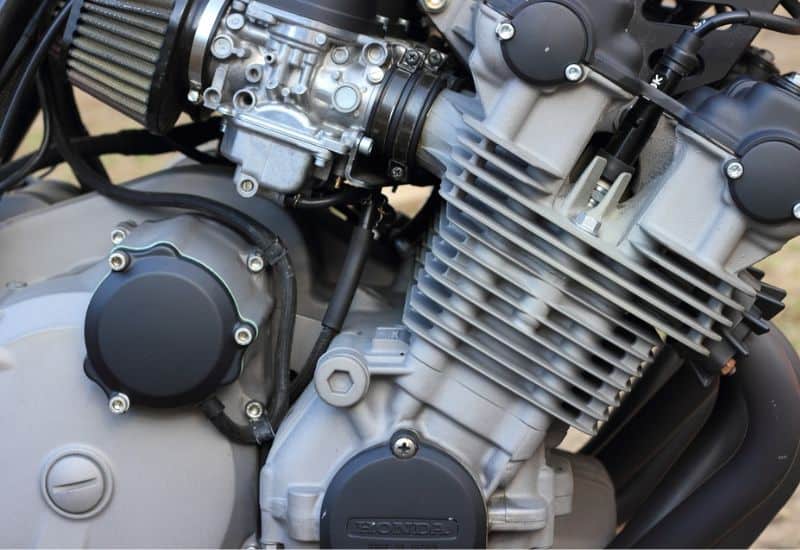
Whether you’re shopping for a new UTV or already own one, it’s important to remember that the stock horsepower rating is not set in stone, as there are always ways you can increase it.
Some methods are relatively simple and can be done at home, while others require more extensive modifications and professional installation.
Best Ways to Increase UTV Horsepower:
- Install a High-Performance Air Intake: Replacing the stock air intake with a high-flow, performance-oriented setup is one of the easiest ways to increase horsepower, as it allows the engine to draw in more air. Cold air intakes, which relocate the air filter to a cooler location, can further improve power output by providing denser, oxygen-rich air to the engine.
- Upgrade the Exhaust System: Installing a high-performance exhaust system is one of the most popular ways to increase UTV horsepower. An aftermarket exhaust can improve flow, reduce backpressure, and allow the engine to breathe more efficiently, resulting in increased power output. Options range from slip-on mufflers to complete header-back systems, with varying levels of performance gains.
- Reprogram the ECU: Modern UTVs feature electronic control units (ECUs) that manage various engine functions. Reprogramming or “flashing” the ECU with a performance tune can optimize fuel delivery, ignition timing, and other parameters to increase horsepower and torque. Many aftermarket tuning solutions are available, but it’s crucial to choose a reputable provider to ensure safe and reliable performance gains.
- Install a Turbocharger or Supercharger: For the most significant horsepower gains, installing a turbocharger or supercharger kit can be a game-changer. These forced induction systems compress the air entering the engine, allowing for more fuel to be burned and dramatically increasing power output. However, these modifications are complex and expensive, often requiring professional installation and additional upgrades to the fuel system, clutch, and drivetrain to handle the increased power.
Things to Keep in Mind Before Increasing Horsepower
When increasing your UTV’s horsepower, it’s essential to consider the potential trade-offs, such as reduced reliability, increased fuel consumption, and changes in noise levels.
It’s also important to ensure that any modifications comply with local regulations and don’t void your vehicle’s warranty. If you’re unsure about performing these upgrades yourself, consult with a professional UTV performance shop to ensure safe and reliable results.
Have More UTV Horsepower Questions? We’ve Got More Answers…
Additional UTV Resources:
- 10 Popular UTVs Under $10,000 (Utility on a Budget)
- Is Your UTV Even Legal? The Ultimate Guide to UTV Titles
- Do UTVs Flip Easily? (The Truth You Need to Know)
Recent Posts
In recent years, off-road enthusiasts have been taking their adventures to the next level by installing UTV underglow lights on their side-by-sides. Which adds a unique visual appeal and improves...
Side by sides, also known as UTVs, are used by a wide range of outdoor enthusiasts from off-roaders to farmers to ranchers, and hunters. As these versatile machines offer a unique blend of...
